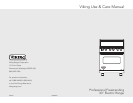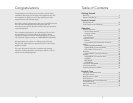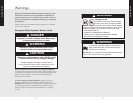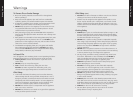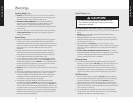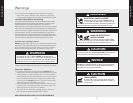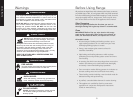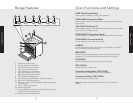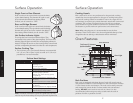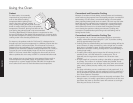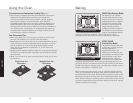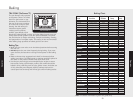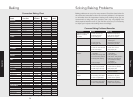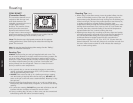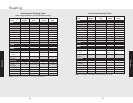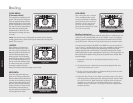
7
6
Warnings
Getting Started
Getting Started
To Prevent Fire or Smoke Damage
• Be sure all packing materials are removed from the appliance
before operating it.
• Keep area around appliance clear and free from combustible
materials, gasoline, and other flammable vapors and materials.
• If appliance is installed near a window, proper precautions should
be taken to prevent curtains from blowing over burners.
•
NEVER leave any items on the rangetop. The hot air from the vent
may ignite flammable items and may increase pressure in closed
containers which may cause them to burst.
• Many aerosol-type spray cans are EXPLOSIVE when exposed to
heat and may be highly flammable. Avoid their use or storage near
an appliance.
• Many plastics are vulnerable to heat. Keep plastics away from parts
of the appliance that may become warm or hot. DO NOT leave
plastic items on the rangetop as they may melt or soften if left too
close to the vent or a surface element.
• Combustible items (paper, plastic, etc.) may ignite and metallic
items may become hot and cause burns.
DO NOT
pour spirits
over hot foods.
DO NOT
leave oven unsupervised when drying
herbs, breads, mushrooms, etc; fire hazard.
In Case of Fire
Turn off appliance and ventilating hood to avoid spreading the flame.
Extinguish flame then turn on hood to remove smoke and odor.
• Cooking Surface: Smother fire or flame in a pan with a lid or
cookie sheet.
• NEVER pick up or move a flaming pan.
• Oven: Smother fire or flame by closing the oven door.
DO NOT use water on grease fires. Use baking soda, a dry
chemical or foam-type extinguisher to smother fire or flame.
Child Safety
• To eliminate the hazard of reaching over hot surface elements,
cabinet storage should not be provided directly above a unit. If
storage is provided, it should be limited to items which are used
infrequently and which are safely stored in an area subjected to
heat from an appliance. Temperatures may be unsafe for some
items, such as volatile liquids, cleaners or aerosol sprays.
• NEVER leave children alone or unsupervised near the appliance
when it is in use or is still hot.
• NEVER allow children to sit or stand on any part of the appliance
as they could be injured or burned.
Child Safety (cont.)
• DO NOT store items of interest to children over the unit. Children
climbing to reach items could be seriously injured.
• Children must be taught that the appliance and utensils in it can
be hot. Let hot utensils cool in a safe place, out of reach of small
children. Children should be taught that an appliance is not a toy.
Children should not be allowed to play with controls or other parts
of the appliance.
Cooking Safety
• ALWAYS place a pan on a surface element before turning it on. Be
sure you know which knob controls which surface element. Make
sure the correct element is turned on. When cooking is completed,
turn element off before removing pan.
• NEVER leave a surface cooking operation unattended especially
when using a high heat setting or when deep fat frying. Boilovers
cause smoking and greasy spillovers may ignite. Clean up greasy
spills as soon as possible. DO NOT use high heat for extended
cooking operations.
• NEVER heat an unopened container on the surface element or in
the oven. Pressure build-up may cause container to burst resulting
in serious personal injury or damage to the appliance.
• Use dry, sturdy pot-holders. Damp pot-holders may cause burns
from steam. Dishtowels or other substitutes should NEVER be
used as potholders because they can trail across hot surface
elements and ignite or get caught on appliance parts.
• ALWAYS let quantities of hot fat used for deep fat frying cool
before attempting to move or handle.
• DO NOT let cooking grease or other flammable materials
accumulate in or near the appliance, hood or vent fan. Clean
hood frequently to prevent grease from accumulating on hood or
filter. When flaming foods under the hood turn the fan off.
• NEVER wear garments made of flammable material or loose
fitting or long-sleeved apparel while cooking. Clothing may ignite
or catch utensil handles.
• ALWAYS place oven racks in the desired positions while oven is
cool. Slide oven rack out to add or remove food, using dry, sturdy
potholders. Always avoid reaching into the oven to add or remove
food. If a rack must be moved while hot, use a dry potholder.
• ALWAYS turn the oven off at the end of cooking.
• Use care when opening the oven door. Let hot air or steam
escape before moving or replacing food.



